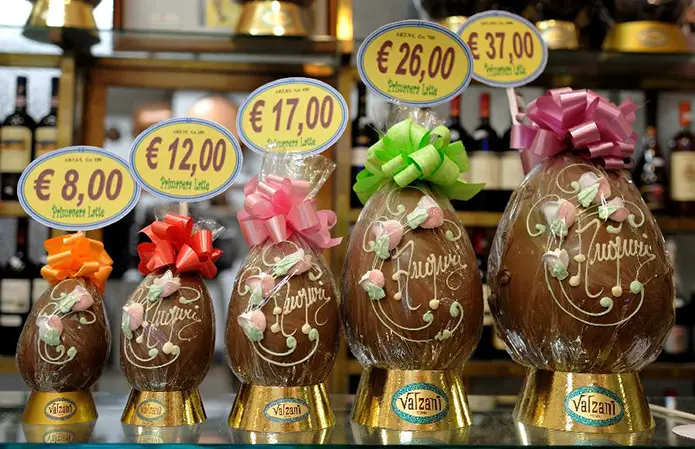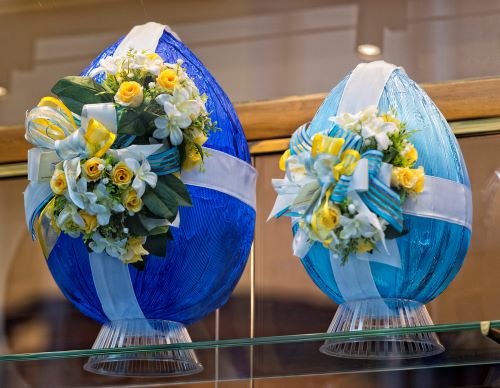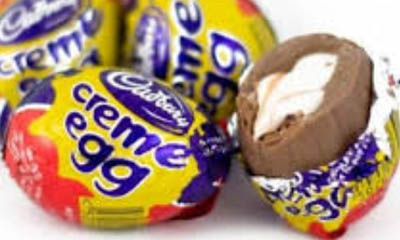
One might think the Easter bunny was a ubiquitous being, and indeed a rabbit brings eggs to good children at Easter in Germany, England, the United States and other countries. But in Switzerland treats come by way of the the Easter Cuckoo. In France flying church bells return from Rome laden with eggs, scattering them in gardens along the way. And then there’s all that chocolate. Where, and when, did these curious Easter traditions begin? As always, we rolled up our sleeves and did a deep dive to unravel this mystery.
Germany
The tradition of a bunny bringing eggs to good children at Easter began in Germany, although no one knows definitively why or how. Many believe the Osterhase, or Easter Hare, to be a mashup of two symbols of spring and new life. Rabbits and hares breed prolifically. In fact, a female hare can conceive a second litter of offspring while still pregnant with the first. So, this came to symbolize eternal life. Birds lay eggs in the spring, a sign of life returning after the dead of winter.
So how did this evolve into a hare delivering eggs?
—and candy, and toys—on Easter morning?
Ostara was an Anglo-Saxon pagan goddess, the symbol of the rising sun and spring. Legend has it that her pet bird was freezing one winter. Out of compassion she turned the bird into a hare so it would have fur to keep it warm. Ergo hare/bird could lay eggs. From the Middle Ages at least, eggs were dyed to observe the Easter (derived from Ostara) tradition. Over the years coloring eggs has evolved into a fine art, with many now decorated quite elaborately, Faberge notwithstanding. Once decorated, we hide the eggs as a special treat for children to find on Easter morning.

The tradition of giving and eating chocolate and candy eggs began in the 1800s. In Germany techniques to make solid chocolate edible were developed, making it possible to produce chocolate Easter eggs. They were solid at first, but by the beginning of the 19th century, modern chocolate making techniques allowed the production of hollow eggs that could be filled with other treats.

In Germany today Easter eggs are not limited to those made of chocolate. Marzipan is also used to make all sorts of seasonal confectionery products including Easter eggs and bunnies.
Family-owned Niederegger GmbH has been a leading producer of marzipan in Germany since 1806.
——————–
article-ad
——————–
While the Niederegger factory is busy year-round, at Christmas and Easter the products fly off the conveyor belts even faster. Their Easter selection includes a range of solid, flavored marzipan eggs, liquor-filled eggs and Easter bunny shaped marzipan figures covered in white, milk or dark chocolate.
The Osterhase has become part of popular German culture in the 20th century, although in parts of Germany Easter eggs are brought by the Osterfuchs (Easter Fox) or the Storch (stork).
Switzerland
In Switzerland, chocolate cuckoos, colored eggs and special cakes are displayed in shop windows in eager anticipation of Easter.
On Easter Sunday, children wake up and search the house and garden for colorful eggs to fill their baskets. The child who finds the most eggs receives additional gifts of chocolate eggs and little chocolate and marzipan rabbits.
One would expect chocolate to play a role in Switzerland, a country where chocolate is almost a dietary staple. But until the early 19th century chocolate was most often consumed in drink form. The Industrial Revolution paddled chocolate into a solid.
François-Louis Cailler built the first mechanized chocolate facility in 1819 and is the oldest Swiss chocolate brand today. In 1875 Daniel Peter first mixed milk and chocolate at his factory in Vevey, Switzerland. Soon after Randolph Lindt developed the world’s first melting chocolate utilizing a special conching process. Needless to say, the Swiss are chocolate experts and longtime connoisseurs.
Today finely decorated chocolate eggs and bunnies can be found from the most exclusive chocolatiers to Migros, a favorite supermarket.
So, who delivers the treats?
There is some question about who brings the Easter eggs to children in Switzerland. Some traditions claim it’s the Easter Cuckoo—which makes sense in the land of cuckoo clocks. The Easter Bunny appeared in certain areas of Germany more than 370 years ago. He also appears in a Swiss children’s song from 1789. Even the Swiss Consulate in New York wasn’t sure and had to check.

Because of the biological impossibility of a hare laying eggs, the cuckoo made more sense. The cuckoo does not build its own nests but places its eggs in another bird’s nest and lets surrogate parent tend them until they hatch. The cuckoo’s behavior could be interpreted as “hiding eggs.” As such, it was the cuckoo and not the hare that is believed to bring Easter eggs.
The Easter Bunny has become truly popular within the last 50 years. Since hares are spotted more often in spring, around Easter, children could believe the bunnies were searching for places to hide eggs.
Today plenty of chocolate bunnies line chocolate shop shelves—around 16 million chocolate Easter bunnies are produced annually in Switzerland. Which means that at Easter, Switzerland, population around 8.5 million people—is inhabited by twice as many Easter bunnies as people.
——————–
——————–
Italy
It’s almost impossible to say these words: there is no. Easter. Bunny. in. Italy. Our guess is that it didn’t want to freeze again crossing over the Alps. But even if there is no bunny, there is plenty of chocolate.
Let’s start at the beginning
The ancient Romans believed that omne vivum ex ovo—all life comes from the egg. Even in ancient Rome eggs were decorated, using vegetable dyes made from onion skins, beets and carrots, and given as gifts during the spring festivals.
As chocolate became increasingly popular in the early 20th Century, the skills of knowing how to color Easter eggs started to fade, and chocolate eggs began to take the place of painted hens’ eggs. Chocolate Easter eggs have now overtaken decorated eggs in Italy as the most popular gift at Easter.

Instead of getting Easter baskets or searching for hidden candy, Italian children get large, hollow chocolate eggs—uova di Pasqua al cioccolato—wrapped in colorful paper. Each egg has a surprise inside—small candies or a toy or both, depending on the size of the egg.
Which are the most popular chocolate Easter eggs in Italy?
Italians take everything chocolate very seriously – and Easter eggs are no exception.
Chocolate eggs have become increasingly elaborate as manufacturers tempt us to buy their eggs.

In every tiny village in Italy, every supermarket, shop window and market stall will have a huge variety of chocolate eggs in the days leading up to Easter Sunday.
They range from the tiny, solid milk chocolate to the massive, showy hollowed out eggs containing sometimes quite elaborate gifts—even engagement rings. All of them will be wrapped in foil or, more commonly, cellophane; most will have at least decorative ribbon, often massive bows.
——————–
——————–
‘Kinder Surprise’ eggs have for some years now been the most popular of chocolate Easter eggs in Italy. Each contains a ‘surprise’ toy, which is what makes them a favorite of children.
Most people assume that the company making the very popular Kinder Eggs is German. In fact, they are made by Ferrero, a hugely successful Italian family company based in the Piemonte region in Italy’s north-west.
France
In France Easter eggs are delivered by flying bells, les cloches volant. Eh? Here’s the story: Church bells in France are not rung on Good Friday to Easter morning. The legend says that on Good Friday all the church bells in France miraculously ‘fly’ off to the Vatican. The bells carry all the grief of those mourning Jesus’ crucifixion.
These flying French bells return, loaded with eggs, on Easter Sunday.

As the bells fly over towns and villages on their return trip the eggs are scattered in gardens, which explains why Easter egg hunts take place outside.
Of course, this being France, there are plenty of chocolate confections to be found in shops and markets, including white and dark chocolate rabbits, chickens, ducks, bunnies, bells…and fish.
Fish? Did we hear that correctly?
Yes. Another unique French tradition is the chocolate fish, which make an appearance at the beginning of April for France’s version of April Fool’s Day.

These fish are called, appropriately, Poisson d’Avril, and have been adopted into the Easter chocolate portfolio. There are also little fish and seafood, friture, that are more immediately associated with Easter: fish are a symbol of Christianity. The friture can be purchased separately or found inside a larger hollow chocolate fish or egg.
For Easter chocolatiers let their imaginations run wild. The windows of chocolate shops and pâtisseries display intricate works of art.

England
In England, the chocolate egg reigns supreme, but it’s the Easter Bunny who brings them and hides them in the garden. English Easter eggs are often hollow chocolate eggs filled with chocolate truffles or sweets, then wrapped in colorful foil. Here’s a peek into an English Easter egg hunt.
The custom of the egg hunt began in Germany and probably was introduced to Queen Victoria by her German-born mother. Victoria and Albert continued the tradition with their children. At the time the eggs were hard boiled and decorated.

Chocolate eggs in England capture the market
While chocolate eggs first appeared in France and Germany in the early 19th century, it wasn’t until 1873 when Fry’s produced the first chocolate Easter egg in the UK.
The first Cadbury Easter Eggs were made in 1875; by 1893, the Cadbury Brothers had 19 different Easter lines. Today Cadbury dominates the chocolate Easter egg market with a more than 50% share. The Cadbury Creme Egg is the most popular; over 500 million Creme Eggs are made every year with about two thirds of them enjoyed in the UK. That is 3.5 Cadbury Creme Eggs for every person in the country.
United States
The Easter Bunny is a major figure in America, having crossed from participant in a religious holiday to a figure in popular culture. Giant Easter Bunnies can be found at malls and in front of chocolate shops in the days leading up to Easter Sunday. And like Santa Claus, the bunny arrives sometime overnight to deliver a gorgeous basket filled with treats to good little boys and girls.

But how did the Easter Bunny migrate to the New World? According to History.com, the bunny first arrived in America in the 1700s with German immigrants who settled in Pennsylvania and brought the German tradition of the Osterhase—or Oschter Haws, as they called him—with them. Their children made nests in which this odd creature could lay its colored eggs. Over time, the custom spread across the U.S.
Eventually, the Osterhase/Oschter Haws became the Easter Bunny, elaborate decorated baskets replaced nests, and the Easter morning deliveries expanded to include chocolate and other types of candy and gifts.
Easter is the second best-selling candy holiday in America, after Halloween. Chocolate Easter bunnies are the most popular. Ninety 90 million chocolate Easter bunnies are made each year—followed chocolate eggs and the jelly bean, another egg-shaped candy. According to the National Confectioners Association, over 16 billion jelly beans are made in the U.S. each year for Easter.

For the past decade, the top-selling non-chocolate Easter candy has been the marshmallow Peep, but the Reese’s egg is quickly climbing the chart. Candystore.com estimates total Easter spending is estimated to be over $18 billion in 2019.
In its article, “What’s the Meaning of Easter Baskets?”, Scientific American notes that it’s become customary “to fill baskets with more than just these symbols of the holiday. Where chocolate bunnies and plastic eggs once reigned supreme, they are now being crowded out in favor of, well, practically anything since almost everything can be repackaged for an Easter gift.”
In recent years Easter baskets have been filled with clothing, books, gift cards, school supplies, and toys, as well as big ticket items like phones, tablets, and laptops. It’s a long way from colored eggs and chocolate bunnies: in 2016, Easter sales in America reached $680 million.
Around the globe and beyond…
The Easter Bunny makes an appearance in many forms in many countries. In Ireland, the Easter Bunny—perhaps a female—hides eggs in the garden for children to find on Easter Sunday morning. Rabbits are an unwelcome, invasive species in Australia, so an effort began to replace the Easter Bunny with the Easter Bilby. In Poland children hunt for sweets and small gifts the Easter bunny hid for them around the house.
If you know of other Easter Bunny traditions let us know and we’ll add your story to these.
* * *
You may also like
- What’s in your chocolate? A peek beneath the wrapper
- The British tea habit—a look behind the cuppa
- Ageless beauty: Secrets of French skin care
Go to the Blue Hare home page for more articles for inquiring women.
